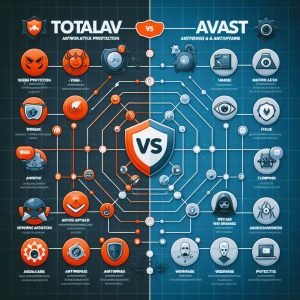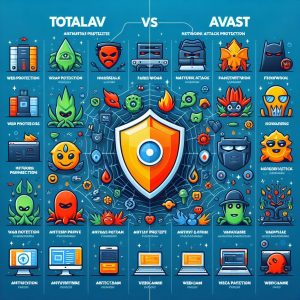Introduction
In today’s digital world, antivirus software is crucial for protecting your devices against malicious threats like viruses, malware, spyware, ransomware, and more. With so many options on the market, it can be tough to decide which antivirus solution is right for your needs. Two of the top antivirus brands are TotalAV and Avast. This comprehensive guide will compare TotalAV and Avast across several key categories to help you determine which software is the better choice.
Pricing and Compatibility
Pricing is often one of the main factors when comparing antivirus platforms. Both TotalAV and Avast offer free antivirus options alongside paid premium packages with additional features.
TotalAV’s free antivirus includes real-time malware protection, a VPN, and basic performance optimization. Upgrading to premium packages adds features like identity theft protection, firewall security, browser protection, and more. TotalAV pricing starts at $19.95 per year for 1 device, and up to 10 devices can be covered under its top premium package costing $79.95 per year.
Avast’s free antivirus provides essential malware protection with additional handy tools like a password manager and limited VPN. Avast One Individual, the lowest cost premium option at $59.99 per year, offers features like ransomware shield, webcam protection, and customizable firewall settings. More expensive family packages are also available.
Both TotalAV and Avast have a reputation for strong compatibility across Windows, Mac, Android, and iOS devices. So regardless of your tech ecosystem, either software should integrate well across desktop and mobile operating systems. Avast perhaps has broader platform support, while TotalAV emphasizes seamless integration between its apps.

Performance and Scanning
Antivirus software needs to provide comprehensive threat scanning without slowing down system performance, so both scan capabilities and impact are important to compare.
TotalAV offers 5 different scan options varying from quick scans to complete full-system scans checking every single file and program. Reviewers found TotalAV scans to be fairly fast compared to competitors – scanning over 470,000 files in just 47 minutes in one test. The passive background scans also have minimal impact, using under 3% of CPU resources on average. This makes TotalAV suitable even for older devices.
Avast provides quick, deep, and full system scans options tuned for performance, along with the customizable boot-time scan on Windows devices. Independent lab tests measured Avast scans at roughly 2 minutes for quick scans and between 20-90 minutes for full scans depending on the system. Avast also earns top marks for low passive resource usage, having nearly no discernible impact on PC performance based on many experts’ benchmarks.
So both TotalAV and Avast are excellent in terms of providing speedy scans with lightweight background impact on system performance and speed. For many use cases, Avast may have the slight edge for best-in-class performance results.
Independent Test Results
Turning to expert third-party test results provides deeper insights into the malware detection capabilities of both platforms. Organizations like AV-Test and AV Comparatives conduct rigorous assessments of leading antiviruses to establish protection and performance standards.
In AV-Test evaluations throughout 2021, both TotalAV and Avast consistently earned top scores in Protection and Performance testing. However, Avast scored marginally higher than TotalAV in core categories like the detection of widespread malware threats on Windows 10 devices. Out of a possible 6 points, Avast earned perfect 6.0 scores across the board in these essential tests, while TotalAV lagged slightly behind at 5.5 points in this particular Windows assessment.
Likewise, AV Comparatives places Avast in the highest “Advanced+” tier designation based on all-around testing, whereas TotalAV lands in the second-best “Advanced” designation. Both provide effective security, but there is a small gap between them when measuring the very best antivirus software tools. Independent lab tests give Avast the edge.
User Interface and Experience
An important factor for many antivirus shoppers is having a smooth, frustration-free user experience. Comparing TotalAV and Avast’s interfaces and usability reveals some advantages and disadvantages.
The TotalAV interface strives for simplicity and transparency in delivering security insights. The dashboard displays notifications clearly with options to quickly resolve issues or dive deeper. Menu navigation is straightforward with core tools being simple to locate. The interface looks polished and feels snappy. This adds up to a welcoming user experience centered around simplifying security management.
Avast has redesigned their interface in recent years for greater usability too. The sleek dashboard provides security alerts, scans status, and custom recommendation all in one view. Core menus feature improved organization and the entire interface has sharp and modern look. However, a downside is still feeling a bit overwhelmed in places with dense menus packed with settings. The abundance of features and notifications can undermine the user experience at times.
Overall, TotalAV’s friendly design and neat presentation tend to be appreciated by individuals less comfortable with complex interfaces. Avast still offers appealing visuals but doesn’t quite match TotalAV’s user experience for clarity and approachability aimed at everyday home users. For tech experts, Avast provides all the advanced control they could want whereas TotalAV errs simpler.

Real-Time Protection and Additional Features
In addition to scans and the user interface itself, evaluating what features are included and real-time activity monitoring abilities give a broader view of the overall security you receive with each platform.
A major advantage TotalAV provides is identity theft protection powered by award-winning monitoring from IPVanish. Dark web surveillance helps detect compromised credentials and data. This adds peace of mind beyond traditional malware protection, especially complementing browser-focused protections TotalAV offers like avoiding phishing sites or dangerous downloads. For keeping your online identity safe, TotalAV is a standout.
Avast has invested substantially in expanding beyond core malware tools over the past few years as well. Avast WiFi Inspector scans home networks for vulnerabilities while their Browser Cleanup browser extension specifically targets annoying ads and trackers when browsing. For winkling out threats associated with dangerous sites and apps, few suites beat Avast.
In terms of sheer real-time performance capabilities though, both platforms benefit again from minimal drag on system resources. Each employ advanced heuristics and machine learning so protection strengthens over time automatically detecting emerging threats with minimal false positives. Experts confirm background monitoring consumes very little memory or CPU making the real-time shields nearly invisible to users while working away to keep devices secure.
Conclusion
After reviewing key areas like pricing, system performance, malware protection reliability, usability, and additional features, is TotalAV or Avast the better choice overall?
The good news is both TotalAV and Avast provide capable security with well-rounded suites at affordable rates. Independent testing does consistently show Avast enjoying small advantages detecting threats during simulated attacks across platforms like Windows and Android. However, TotalAV frequently matches or exceeds Avast specifically when testing malware found in the wild. Ultimately both can effectively secure home consumer devices.
Avast excels with near perfect malware detection thanks to robust databases that fuel an array of advanced shields spanning devices. The customizable dashboards and settings menus give experts plenty of control yet still enable novice users to apply protection easily. If seeking a powerful do-it-all suite with tools addressing emerging attack vectors like dangerous networks, Avast hits the mark.
TotalAV makes security management extremely friendly for home users less inclined toward intricate interfaces yet also packs the core anti-malware punch relying on proven scanning. Their specialist focus around safeguarding online identities and browsing gives TotalAV unique appeal for preserving privacy too. For those valuing simplicity plus identity theft features, TotalAV satisfies.
Weigh individual factors like pricing, platforms used, and preference for simpler versus expansive dashboards when deciding between Avast versus TotalAV. In closing, adopting either solution over having no up-to-date antivirus protection makes for smart security. Both programs constitute leading choices for keeping your devices and personal data away from modern cyber dangers.